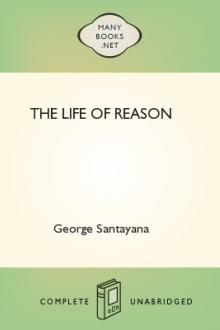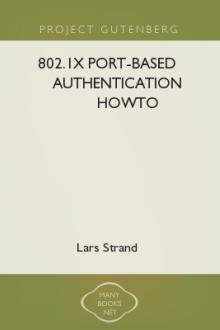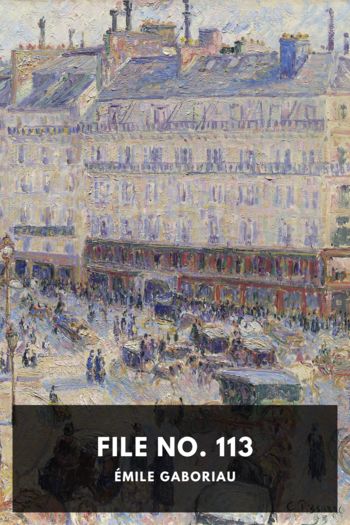The Life of Reason, George Santayana [e novels to read .txt] 📗

- Author: George Santayana
- Performer: -
Book online «The Life of Reason, George Santayana [e novels to read .txt] 📗». Author George Santayana
In order to reconstitute the image we may take an abstract representation or hieroglyphic and gradually increase its depth and its scope. As the painter becomes aware of what at first he had ignored, he adds colour to outline, modelling to colour, and finally an observant rendering of tints and values. This process gives back to objects their texture and atmosphere, and the space in which they lie. From a representation which is statuesque in feeling and which renders figures by furnishing a visible inventory of their parts and attributes, the artist passes to considering his figures more and more as parts of a whole and as moving in an ambient ether. They tend accordingly to lose their separate emphasis, in order to be like flowers in a field or trees in a forest. They become elements, interesting chiefly by their interplay, and shining by a light which is mutually reflected.
When this transformation is complete the painting is essentially a landscape. It may not represent precisely the open country; it may even depict an interior, like Velasquez's Meninas. But the observer, even in the presence of men and artificial objects, has been overcome by the medium in which they swim. He is seeing the air and what it happens to hold. He is impartially recreating from within all that nature puts before him, quite as if his imagination had become their diffused material substance. Whatever individuality and moral value these bits of substance may have they acquire for him, as for nature, incidentally and by virtue of ulterior relations consequent on their physical being. If this physical being is wholly expressed, the humanity and morality involved will be expressed likewise, even if expressed unawares. Thus a profound and omnivorous reverie overflows the mind; it devours its objects or is absorbed into them, and the mood which this active self-alienation brings with it is called the spirit of the scene, the sentiment of the landscape.
Perception and art, in this phase, easily grow mystical; they are readily lost in primordial physical sympathies. Although at first a certain articulation and discursiveness may be retained in the picture, so that the things seen in their atmosphere and relations may still be distinguished clearly, the farther the impartial absorption in them goes, the more what is inter-individual rises and floods the individual over. All becomes light and depth and air, and those particular objects threaten to vanish which we had hoped to make luminous, breathing, and profound. The initiated eye sees so many nameless tints and surfaces, that it can no longer select any creative limits for things. There cease to be fixed outlines, continuous colours, or discrete existences in nature.
An artist, however, cannot afford to forget that even in such a case units and divisions would have to be introduced by him into his work. A man, in falling back on immediate reality, or immediate appearance, may well feel his mind's articulate grammar losing its authority, but that grammar must evidently be reasserted if from the immediate he ever wishes to rise again to articulate mind; and art, after all, exists for the mind and must speak humanly. If we crave something else, we have not so far to go: there is always the infinite about us and the animal within us to absolve us from human distinctions.
Moreover, it is not quite true that the immediate has no real diversity. It evidently suggests the ideal terms into which we divide it, and it sustains our apprehension itself, with all the diversities this may create. To what I call right and left, light and darkness, a real opposition must correspond in any reality which is at all relevant to my experience; so that I should fail to integrate my impression, and to absorb the only reality that concerns me, if I obliterated those points of reference which originally made the world figured and visible. Space remains absolutely dark, for all the infinite light which we may declare to be radiating through it, until this light is concentrated in one body or reflected from another; and a landscape cannot be so much as vaporous unless mists are distinguishable in it, and through them some known object which they obscure. In a word, landscape is always, in spite of itself, a collection of particular representations. It is a mass of hieroglyphics, each the graphic symbol for some definite human sensation or reaction; only these symbols have been extraordinarily enriched and are fused in representation, so that, like instruments in an orchestra, they are merged in the voluminous sensation they constitute together, a sensation in which, for attentive perception, they never cease to exist.
Impatience of such control as reality must always exercise over representation may drive painting back to a simpler function. When a designer, following his own automatic impulse, conventionalises a form, he makes a legitimate exchange, substituting fidelity to his apperceptive instincts for fidelity to his external impressions. When a landscape-painter, revolting against a tedious discursive style, studies only masses of colour and abstract systems of lines, he retains something in itself beautiful, although no longer representative, perhaps, of anything in nature. A pure impression cannot be illegitimate; it cannot be false until it pretends to represent something, and then it will have ceased to be a simple feeling, since something in it will refer to an ulterior existence, to which it ought to conform. This ulterior existence (since intelligence is life understanding its own conditions) can be nothing in the end but what produced that impression. Sensuous life, however, has its value within itself; its pleasures are not significant. Representative art is accordingly in a sense secondary; beauty and expression begin farther back. They are present whenever the outer stimulus agreeably strikes an organ and thereby arouses a sustained image, in which the consciousness of both stimulation and reaction is embodied. An abstract design in outline and colour will amply fulfil these conditions, if sensuous and motor harmonies are preserved in it, and if a sufficient sweep and depth of reaction is secured. Stained-glass, tapestry, panelling, and in a measure all objects, by their mere presence and distribution, have a decorative function. When sculpture and painting cease to be representative they pass into the same category. Decoration in turn merges in construction; and so all art, like the whole Life of Reason, is joined together at its roots, and branches out from the vital processes of sensation and reaction. Diversity arises centrifugally, according to the provinces explored and the degree of mutual checking and control to which the various extensions are subjected.
Organisation, both internal and adaptive, marks the dignity and authority which each art may have attained; but this advantage, important as is must seem to a philosopher or a legislator, is not what the artist chiefly considers. His privilege is to remain capricious in his response to the full-blown universe of science and passion, and to be still sensuous in his highest imaginings. He cares for structure only when it is naturally decorative. He thinks gates were invented for the sake of triumphal arches, and forests for the sake of poets and deer. Representation, with all it may represent, means to him simply what it says to his emotions. In all this the artist, though in one sense foolish, in another way is singularly sane; for, after all, everything must pass through the senses, and life, whatever its complexity, remains always primarily a feeling.
To render this feeling delightful, to train the senses to their highest potency and harmony in operation, is to begin life well. Were the foundations defective and subject to internal strain there could be little soundness in the superstructure. Æsthetic activity is far from being a late or adventitious ornament in human economy; it is an elementary factor, the perfection of an indispensable vehicle. Whenever science or morals have done violence to sense they have decreed their own dissolution. To sense a rebellious appeal will presently be addressed, and the appeal will go against rash and empty dogmas. A keen æsthetic sensibility and a flourishing art mark the puberty of reason. Fertility comes later, after a marriage with the practical world. But a sensuous ripening is needed first, such as myth and ornament betray in their exuberance. A man who has no feeling for feeling and no felicity in expression will hardly know what he is about in his further undertakings. He will have missed his first lesson in living spontaneously and well. Not knowing himself, he will be all hearsay and pedantry. He may fall into the superstition of supposing that what gives life value can be something external to life. Science and morals are themselves arts that express natural impulses and find experimental rewards. This fact, in betraying their analogy to æsthetic activity, enables them also to vindicate their excellence.
CHAPTER IXJUSTIFICATION OF ART
It is no longer the fashion among philosophers to decry art. Either its influence seems to them too slight to excite alarm, or their systems are too lax to subject anything to censure which has the least glamour or ideality about it. Tired, perhaps, of daily resolving the conflict between science and religion, they prefer to assume silently a harmony between morals and art. Moral harmonies, however, are not given; they have to be made. The curse of superstition is that it justifies and protracts their absence by proclaiming their invisible presence. Of course a rational religion could not conflict with a rational science; and similarly an art that was wholly admirable would necessarily play into the hands of progress. But as the real difficulty in the former case lies in saying what religion and what science would be truly rational, so here the problem is how far extant art is a benefit to mankind, and how far, perhaps, a vice or a burden.
That art is prima facie and in itself a good cannot be doubted. It is a spontaneous activity, and that settles the question. Yet the function of ethics is precisely to revise prima facie judgments of this kind and to fix the ultimate resultant of all given interests, in so far as they can be combined. In the actual disarray of human life and desire, wisdom consists in knowing what goods to sacrifice and what simples to pour into the supreme mixture. The extent to which æsthetic values are allowed to colour the resultant or highest good is a point of great theoretic importance, not only for art but for general philosophy. If art is excluded altogether or given only a trivial rôle, perhaps as a necessary relaxation, we feel at once that a philosophy so judging human arts is ascetic or post-rational. It pretends to guide life from above and from without; it has discredited human nature and mortal interests, and has thereby undermined itself, since it is at best but a partial expression of that humanity which it strives to transcend. If, on the contrary, art is prized as something supreme and irresponsible, if the poetic and mystic glow which it





Comments (0)